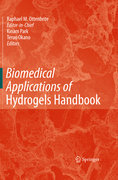
Hydrogels are networks of polymer chains which can produce a colloidal gel containing over 99 per cent water. The superabsorbency and permeability of naturally occurring and synthetic hydrogels give this class of materials an amazingarray of uses. These uses range from wound dressings and skin grafts to oxygen-permeable contact lenses to biodegradable delivery systems for drugs or pesticides and scaffolds for tissue engineering and regenerative medicine. Biomedical Applications of Hydrogels Handbook provides a comprehensive description ofthis diverse class of materials, covering both synthesis and properties and abroad range of research and commercial applications. The Handbook is divided into four sections: Stimuli-Sensitive Hydrogels, Hydrogels for Drug Delivery, Hydrogels for Tissue Engineering, and Hydrogels with Unique Properties. Key Features: Provides comprehensive coverage of the basic science and applications of a diverse class of materials Includes both naturally occurring and synthetic hydrogels Edited and written by world leaders in the field. First comprehensive handbook since 1987 on the basic science and applications of an important and diverse class of materials Covers applications to medicine and drug delivery, cosmetics and other consumer products, foods, agriculture, nanotechnology,and environment-sensitive sensing devices Describes both naturally occuring and synthetic hydrogels Edited and written by world leaders in the field INDICE: From the contents Part 1: Stimuli-Sensitive Hydrogels.- Part 2: Hydrogels For Drug Delivery.- Part 3: Hydrogels For Tissue Engineering.- Part 4:Hydrogels With Unique Properties.
- ISBN: 978-1-4419-5918-8
- Editorial: Springer
- Encuadernacion: Cartoné
- Páginas: 500
- Fecha Publicación: 01/06/2010
- Nº Volúmenes: 2
- Idioma: Inglés
